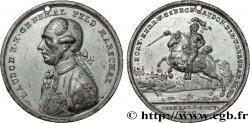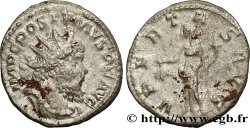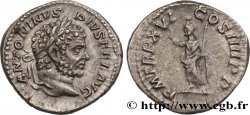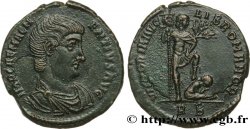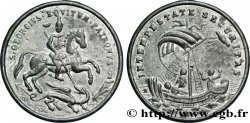Live auction - fme_582181 - AUSTRIA - JOSEPH II Boîtier et son panoramique, Mariage de Josépha avec Joseph II, futur Empereur d’Autriche
You must signin and be an approved bidder to bid, LOGIN TO BID. Accounts are subject to approval and the approval process takes place within 48 hours. Do not wait until the day a sale closes to register. Clicking on "BID" constitutes acceptance of the terms of use of cgb.fr private live auctions.
Bids must be placed in whole Euro amounts only. The sale will start closing at the time stated on the item description; any bids received at the site after the closing time will not be executed. Transmission times may vary and bids could be rejected if you wait until the last second. For further information check the Live auction FAQ
All winning bids are subject to a 18% buyer’s fee.
All winning bids are subject to a 18% buyer’s fee.
| Estimate : | 2 500 € |
| Price : | no bid |
| Maximum bid : | no bid |
| End of the sale : | 03 June 2025 17:47:33 |
Type : Boîtier et son panoramique, Mariage de Josépha avec Joseph II, futur Empereur d’Autriche
Date: 1765
Metal : tin
Diameter : 51,5 mm
Orientation dies : 12 h.
Weight : 50,64 g.
Puncheon : sans poinçon
Coments on the condition:
Bel objet mais le papier présente quelques rousseurs. Ce boîtier en étain présente des étiquettes collées à l’intérieur. Il renferme à l’intérieur un panoramique en 34 rondibules de papier des célébrations des noces de Joseph II avec Maria Josepha de Bavière en 1765.
Catalogue references :
Predigree :
Cet exemplaire provient de la Collection Terisse
Obverse
Obverse legend : DENKWÜRDIGKEITEN / DESS FESTINSSS / BEY DER HOHEN VERMÄHLUNG / SR. RÖM. KÖNIGL. MAJESTET / JOSEPHO II / MIT SR. HOHEIT / JOSEPHA MARJA / KAISS : PRINSSESSIN VON BAYERN / A° 1765, VOM 6TEN BISS 31 TEN JENER / ZU MÜNCHE U: WIEN GEHALTE / - / AUGSPURG ZU FINDEN BEY / J.F. REIN, KUPFER / STECHERN.
Obverse translation : Événements mémorables des célébrations tenues / à l’occasion des Noces Souveraines de sa Romaine-Royale Majesté JOSEPH II avec sa Majesté JOSEPHA MARIA Princesse Impériale de Bavière en 1765, du 6 au 31 Janvier à Munich et à Vienne. A trouver à Augsbourg chez J . F . Rein, graveurs sur cuivre.
Reverse
Reverse description : Armoiries couronnées de l’alliance de Hasbourg et de la Bavière.
Commentary
Ce boîtier en étain, avec les armoiries couronnées de l’alliance de Habsbourg et de la Bavière à l’intérieur, présente des étiquettes collées à l’intérieur. Il renferme à l’intérieur un panoramique en 34 rondibules de papier colorés des différentes célébrations des noces de Joseph II avec Maria Josepha de Bavière en 1765.
Le panoramique se présente en bande continue, en commençant par les portraits en couleurs de Joseph II puis de Josepha Maria, avant de continuer par une vue sur la salle du banquet dans la grande salle impériale. Parmi les événements, on voit une représentation de l’opéra Sémiramis, les noces de village sur la place et dans l’église. On voit ensuite la scène du bal des prétendants, le château de Nymphenburg, le départ de la mariée vers Munich, puis son accueil par sa majesté Romaine Impériale et le mariage presbytéral dans la grande Salle de la Galerie. La série se termine par une fête théâtrale suivie de l’arrivée à Vienne et une vue sur le château de Schönbrunn.
Dans l’ouvrage d’Henri Terisse, vous retrouverez le détail et la traduction de chaque rondibule ou l’explication de la scène représentée.
This tin case, with the crowned coat of arms of the Habsburg and Bavarian alliance inside, has labels glued to the inside. Inside it contains a panorama in 34 colored paper circles of the different celebrations of the wedding of Joseph II with Maria Josepha of Bavaria in 1765..
The panorama is presented in a continuous strip, beginning with the color portraits of Joseph II and then of Josepha Maria, before continuing with a view of the banquet hall in the great imperial hall.. Among the events are a performance of the opera Semiramis, the village wedding in the square and in the church. We then see the scene of the suitors' ball, Nymphenburg Palace, the bride's departure for Munich, then her welcome by Her Imperial Roman Majesty and the presbyteral wedding in the great Hall of the Gallery.. The series ends with a theatrical celebration followed by the arrival in Vienna and a view of Schönbrunn Palace..
In Henri Terisse's work, you will find the details and the translation of each rondibule or the explanation of the scene represented
Le panoramique se présente en bande continue, en commençant par les portraits en couleurs de Joseph II puis de Josepha Maria, avant de continuer par une vue sur la salle du banquet dans la grande salle impériale. Parmi les événements, on voit une représentation de l’opéra Sémiramis, les noces de village sur la place et dans l’église. On voit ensuite la scène du bal des prétendants, le château de Nymphenburg, le départ de la mariée vers Munich, puis son accueil par sa majesté Romaine Impériale et le mariage presbytéral dans la grande Salle de la Galerie. La série se termine par une fête théâtrale suivie de l’arrivée à Vienne et une vue sur le château de Schönbrunn.
Dans l’ouvrage d’Henri Terisse, vous retrouverez le détail et la traduction de chaque rondibule ou l’explication de la scène représentée.
This tin case, with the crowned coat of arms of the Habsburg and Bavarian alliance inside, has labels glued to the inside. Inside it contains a panorama in 34 colored paper circles of the different celebrations of the wedding of Joseph II with Maria Josepha of Bavaria in 1765..
The panorama is presented in a continuous strip, beginning with the color portraits of Joseph II and then of Josepha Maria, before continuing with a view of the banquet hall in the great imperial hall.. Among the events are a performance of the opera Semiramis, the village wedding in the square and in the church. We then see the scene of the suitors' ball, Nymphenburg Palace, the bride's departure for Munich, then her welcome by Her Imperial Roman Majesty and the presbyteral wedding in the great Hall of the Gallery.. The series ends with a theatrical celebration followed by the arrival in Vienna and a view of Schönbrunn Palace..
In Henri Terisse's work, you will find the details and the translation of each rondibule or the explanation of the scene represented







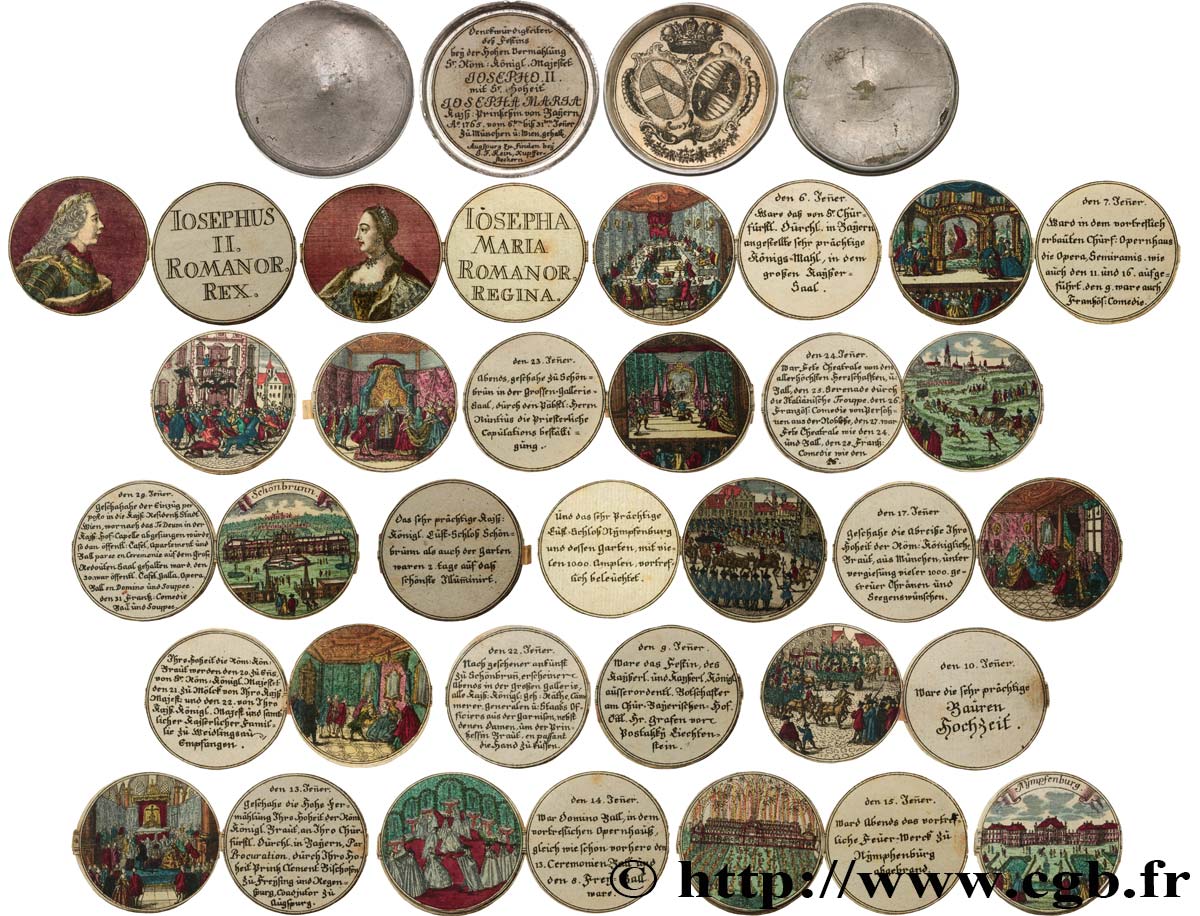
 Report a mistake
Report a mistake Print the page
Print the page Share my selection
Share my selection Ask a question
Ask a question Consign / sell
Consign / sell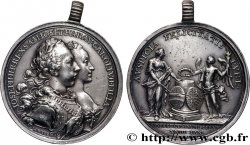
 Full data
Full data